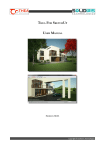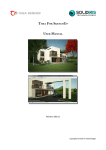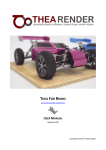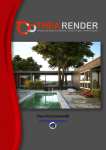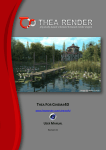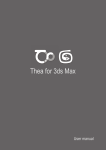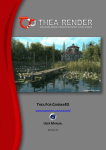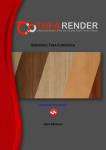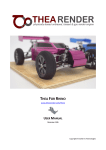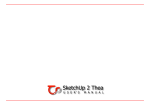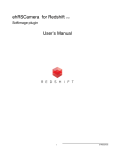Download Manual - Thea Render
Transcript
Thea For SketchUp www.thearender.com/sketchup User Manual Table Of Contents Introduction Installation General Layout of the Plugin Windows Activation Main Window Control Bar Main Window Tabs Display Tab Window Selection for Interactive Rendering – Overlay option Batch Render Window Thea Browser Window Thea Tool Window Camera Tab Material Tab Material Laboratory (Mat-Lab) Light Tab Tools Tab Creating External Models & Their Proxies License Terms Disclaimer Appendix A - Material Preset Types 1 1 2 2 3 3 4 5 8 9 10 11 11 12 13 13 15 17 19 19 20 Introduction Thea for SketchUp is an integrated version of Thea Render. This allows a creation of stunning images right inside SketchUp and an interactive work with cameras, materials and lights. There is an option of saving a complete Thea scene with all associated files for utilizing advanced tools present in Thea Studio. Thea For SketchUp supports SketchUp Versions 6, 7, 8, 2013, 2014 and 2015 both Free(Make) and Pro, on both systems: Windows & OS X. For downloads and plugin features please visit www.thearender.com/sketchup Installation MS Windows Please use the provided Bundle installer, which contains Thea Studio and the SketchUp plugin. Please make sure you have administrator rights while installing the plugin. To ensure that right-click the installer file and select “Run as Administrator”. A destination folder will be automatically found in case of SketchUp versions 6, 7, 8, 2013, 2014 and 2015. Mac - OSX Please use the provided Bundle installer, which contains Thea Studio and the SketchUp plugin. The installer will guide you through the needed installation steps. It also gives you the possibility to select the SketchUp version(s) for the plugin to be installed. A destination folder will be automatically found in case of SketchUp versions 6, 7, 8, 2013, 2014 and 2015. 1 Copyright © Solid Iris Technologies General Layout of the Plugin Windows Once the plugin is installed correctly a new item in the Plugins menu will appear: You can also have access to Thea for SketchUp through tools palette. Select “Show Thea toolbar” from the plugin menu. A toolbar as seen in will appear on the screen: User interface of the plugin consists of three windows: Thea Tool Window It allows setting up cameras, editing materials, placing and editing lights, exporting a scene to Thea Studio and defining other preferences. Thea Main RENDERING Window Thea Browser This button opens Thea Browser Window that helps with easy inserting Thea models, materials, skies and SketchUp components/proxies. The main window displays currently rendered image, allows engines and rendering mode selections, provides controls over the displayed rendering, its channels and environment settings. Tip: in case the plugin is not enabled you can go at Preferences of SketchUp > Extensions and enabled it at the list. Activation For activating the plugin you need to open Thea Tool window , open Tools tab and click on ‘License’ button. 1. 2. 3. ‘License Input Form’ window will open and you will be asked to enter your license details exactly as in a license e-mail: 4. 1. Your full name 2. E-mail address 3. Thea Studio Serial number 4. Press ‘Activate License’ 5-6. Open Plugins tab and enter SketchUp plugin serial number. 7. Press ‘Activate Plugin Licenses’ 5. Demo version limitations Please not that while plugin is not licensed, rendered image resolution will be limited (1280x720) and watermarks will be added. All other features and functionality are fully supported. 6. 7. 8. Copyright © Solid Iris Technologies 2 Main Window Thea rendering window contains three parts: Rendering panel - “darkroom” It displays rendered image with resolution information and elapsed rendering time. When double click it maximizes window size. Control bar Lets you start/pause/stop rendering, save current image and displays current progress Settings Tabs Allows you to modify rendering options, display, environment, channels, animation settings and show additional information in the console tab. Control Bar Save button Render Phase info In this area we see some details concerning our rendering progress or the time needed to be finished. It allows to save the current render as an image and also the currently rendered model as *.pack.thea or *.scn.thea file that can be opened then in Thea Studio. Render Selection Check box when enabled before rendering, only current selection will be rendered. Refresh button It forces a refresh of a current view of the rendering. It is usually being used when one wants to see immediately the progress of the rendering being done. The plugin refreshes the view automatically at some intervals. Stop button It stops the rendering and makes Thea refresh the main window, so it displays the final image. Open Batch Render window Start/Pause button With this button you can open the Batch Render window and select among Scenes those that you need to add in queue for rendering. All details on this window are described on page 9. Start button makes Thea collect all necessary data from SketchUp and start the rendering process. Pause button (appears instead of the Start button when rendering is in progress) pauses the rendering. Tip: You can double click on the control bar to get all tabs below hidden. It is useful when doing an interactive presentation or when more space for the rendering window is needed. 3 Copyright © Solid Iris Technologies Main Window Tabs Rendering Tab Rendering Mode Rendering limits Interactive option Display selection Rendering parameters Device selection for Presto Rendering Modes The control provides a selection among Thea Render engines. There are several options that allow also an interactive type of rendering (IR indication). Most of rendering modes are progressive, which means that user decides when expected quality of an image is reached. Interactive Modes (IR) Non-Interactive Modes Those modes allow not only render the model as a static image, but also let interactively move a camera around a model, adjust shadow, materials, modify model and see the rendering being updated. There are three non-Interactive high quality modes available: • Adaptive (BSD) In many cases fast method based on presets, but it requires some experience when a certain set-up is advantageous. • IR-Presto (AO) • IR-Presto (MC) For fast rendering Presto engines can be selected as they use both your GPU+CPU. You can define extra parameters for devices used by Presto engines at Devices window. Preto Modes with Bucket Render enabled will start rendering in tiles. It allows rendering of big resolution and multiple channels images and avoids memory limitation issues that may otherwise occur. • Adaptive (AMC) This progressive method works very well with multiple lights and complex lighting conditions. Most important parameter for IR engines is the 'Tracing Depth' which defines how many times light bounces in a model. Values starting from 4 give good results in simple conditions, while a higher number is needed when there are many highly reflective surfaces in a model. When ‘Interactive’ option is enabled you can choose where the live rendering will be displayed. Thea for SketchUp can render either in Thea Main Window or directly in SketchUp using Thea Overlay method! For detailed description of available blending options with SketchUp view please check page 8. For detailed description of parameters of rendering methods, please refer to Thea Render manual. Tip: When rendering interactively a screen resolution instead of camera resolution is being used. Disable ‘Interactive’ option to render at full size. Copyright © Solid Iris Technologies 4 Presets are prepared for Exterior and Interior scenarios. Basic preset already gives good result in many cases. Please note that Interior methods are memory hungry and it is not advised to use them in 32 bit versions of SketchUp or when less then 4GB of RAM is available. Unbiased methods Those progressive engines don't require any settings and deliver renderings of the highest quality: • Unbiased (TR1) engine It is preferred in exterior renders and interiors where direct lighting is the most dominant in the scene. • Unbiased (TR2) engine It is preferred when difficult indirect lighting is dominant in the render or heavy caustics are present (such as a sun pool caustics). Tip: For advanced users - you can create your custom Adaptive(BSD) preset inside Thea Studio. Edit Adaptive(BSD) render settings, save them (Render/Presets/Save current settings) and copy from ‘Thea Data/Presets’ folder to SketchUp ‘Plugins/Thea4SU_files/presets’. Server - Network Rendering Server option is available for non-Interactive rendering and lets perform a network rendering, with the use of other machines with rendering nodes installed. When it is enabled a new Tab called ‘Network Log’ appears. The Network Log shows all machines that are connected to SketchUp server and their status, how much they contributed to the rendering so far, number of contributions and technical details about them. Super-sampling This corresponds to the super-sampling used for the image output, i.e. internal resolution multiplier for anti-aliasing enhancement. None corresponds to no super-sampling, Normal to 2x2 and High to 3x3. Auto corresponds to no super-sampling for biased engine and 2x2 for unbiased engines. Setting super-sampling to a higher level will generally improve anti-aliasing of the output but will increase memory demands for storing the image (4 times in Normal level and 9 times in High level). The time needed to render the scene will also be increased for biased engine. But for the unbiased engines, the extra time needed to render the higher resolution image is usually amortized by the reduced noise visible in the visualized (down-sampled) image. It is usually suggested, for unbiased rendering, to change super-sampling to None for high resolution output and High when there is persisting noise. Threads This is the entry for the render worker threads that will be used during rendering (not all application process threads). The special value 0, same like Max, corresponds to the number of logical cores on your machine. Exceeding this value (shown explicitly as the last value in the drop-down list) will have no benefit and actually an impact on performance. Limits for unbiased methods Progressive unbiased rendering modes can render indefinitely until user decides that a rendering quality is good enough. Time and samples limits allow to stop rendering when a first of those two conditions is met. • Time (minutes) Time limit is given in minutes. Rendering stops after specified time. Value of 0 means no time limit. • Samples/px Samples limit stops rendering when all pixels in an image have been sampled specified number of times. In simple lighting condition cases a value of 300 is sufficient. In more complex interior scenes higher values may be needed. Value of 0 means there is no samples limit. By default the limit is set to 512 samples per pixel. Display Tab Display Tab is a very important space where you can manipulate your rendered image, especially in terms of exposure/brightness, colors saturation, contrast and apply any post-processing. First two sections are related to a render exposure and the following three to a filtering. Please note that Glare filter requires a considerable amount of time to perform on larger images. When rendering it is being disabled to save processing power. For a detailed description of all options, please refer to Thea Render Darkroom tutorial – Section 2A. Tip: If a rendering looks too dark it is usually caused by exposure settings in the very first column. In general: • ISO: Higher value = Brighter image • Shutter speed: Lower value = Brighter image • f-number: Lower value = Brighter image 5 Copyright © Solid Iris Technologies Environment Tab Use Sky It tells Thea to create a background for a rendered scene in a form of Physical Sky. It will look as a clear sky which will be automatically adjusted to a position of the Sun. Turning this on makes plugin disable the background image, if it is being used. Environment Preview Use Sun Use Ground It tells Thea to create the Sun that will give same shadows as those present in a SketchUp model. This window shows a preview of environment which is being automatically updated. When Manual Sun is disabled and IBL lighting used, then the environment maps can be rotated by dragging the preview image. This button toggles a ground plane that catch shadows and can also reflect objects above it Edit Settings - allow to open the corresponding panels for editing. IBL - Image Based Lighting By selecting the IBL edit settings, the panel with the corresponding panel appears where user can specify the Illumination, Background, Reflection and Refraction maps. Image-based lighting is a convenient way to add illumination to your scene, coming from captured photos of the surrounding environment. Since a photo of a real scene can be used, the lighting is highly convincing and enhances the realism of your renders. In most cases, the images used for this kind of lighting need to be of high dynamic range in order to provide enough lighting for a scene. One can use an image for illuminating the scene, nevertheless, he can also set up different images for background, reflections and refractions. This makes possible to use different source for lighting and for reflections/background, which in most cases need more details in the image. This is actually a usual render optimization, where the illumination source is relatively low-detailed texture in order for the image to quickly “converge”, while background and reflections use a detailed map for visually enhanced results. To add one of image types select proper type and press ‘Browse’ button to select a desired image. When proper bitmap selected its path will be displayed in the adjacent horizontal input box. One can control intensity, rotation and a way the image is wrapped around a model. Sun The Sun intensity, position and spectral color is handled by the plugin automatically, based on Shadow settings in SketchUp. There is an option to override those settings when it is needed. When ‘Manual Sun’ enabled you can modify a softness of Sun shadows with the multiplier, power and emittance settings. If you want to have a complete control over the Sun position regardless of SketchUp’s Shadow settings, then disable ‘SU position’. You are able to adjust the sun Polar Angle and Azimuth, either by entering the desired values, or manually, by opening the Environment Preview and clicking preferred location in the preview. Copyright © Solid Iris Technologies 6 Ground & Sky Ground settings let you control a way the ground plane reflects light. You can specify roughness of the reflections as well as their intensity (%) and color. Sky settings affect the appearance of Thea Physical Sky. The most important is the very first parameter which takes value ~2.5 for a clear and close to 10.0 for an overcast sky. Channels Tab This tab is being used when an additional image is being required, other than a standard rendering. This is mostly used when a post-processing is intended using external image manipulation program. Available channels are: Color (standard rendering) , Normal, Depth, Alpha, Object Id, Material Id and channels specific to Adaptive(BSD) rendering mode: Direct, Ambient Occlusion, Global Illumination, Sub-Surface Scattering, Reflection, Refraction, Transparency and Irradiance. Some channels like Shadow Channel, Raw Diffuse Color, Raw Diffuse Lighting, Raw Diffuse GI, Self Luminance and Pass per Light are only available to Presto engines. Luminance Analysis describe the luminance and illuminance distribution. Thea Render can compute both of them. Luminance is computed out of the box for any image that you have already rendered and for any render settings. Illuminance can be computed by the Adaptive BSD engine. To view the analysis of a rendered image select ‘Photometric’ from the drop down menu. ‘Min Il – Lum’ and ‘Max Il – Lum’ parameters control a range of illumination the analysis is performed on. Animation Tab This tab contains all needed settings related to animation. Here you can select if camera and/or objects animations will be used. Camera movement will follow exactly same path as it moves in SketchUp. Field of view changes during animation won't be applied. For Adaptive (BSD) engine you can also enable the Walkthrough option (in case of camera movement only) and define the lighting precision. 'Frames per second' parameter controls how fluid an exported animation will be. Animation rendering can be only started by pressing 'Render Animation' button. Console Tab Thea For SketchUp uses the console to send you messages informing you about current state of rendering, time in which rendering was finished and warnings. In general visiting the console is recommended if something doesn’t work as expected. It can help you finding a source of problem - no light in a model or missing texture. 7 Copyright © Solid Iris Technologies Window Selection for Interactive Rendering – Overlay option Below the Rendering Engines list, when Interactive Render is enabled, a selection box with options allows define whether the interactive rendering will be shown inside Thea window (right image) or inside SketchUp (images below) as an Overlay. ‘With edges’ mode is especially suited for interaction with SketchUp model. This mode temporarily modifies SketchUp display style to allow the best visibility edges in exterior/interior models. You can navigate, modify materials, add models and see the changes appearing in SketchUp while rendering. ‘Blended’ and ‘Multiplied’ options give you full freedom of setting up SketchUp style. ‘Blended’ works best with dark backgrounds and bright lines (as in ‘With edges’). ‘Multiplied’ works opposite - hidden line mode with white background looks best. The rendering can be saved as an image, both in standard and overlay modes. Rendering in Thea Window In SketchUp Window In SketchUp With Edges Blended With SketchUp Multiplied With SketchUp Tip: While using the Overlay and modifying model, the best results can be achieved with Presto engines using only GPU for rendering. CPU should be unused and made available to SketchUp Copyright © Solid Iris Technologies 8 Interactive Region Rendering in SketchUp window Interactive Rendering inside SketchUp window, allows you to render just a selected area of you camera view. You can mark the desired part of SketchUp view, when Interactive Rendering is on, by holding Shift button. ‘Drag to select a region’ tool-tip will appear, then you can drag a frame to cover required area. Multiple regions can be displayed at the same time. You can also save an active region by pressing the save button. Region Render in Darkroom When a rendering is done sometimes there is a small thing in an image that has to be altered, that doesn’t affect the rest of it. With a right click and dragging you can select a part of the rendered image - a green dashed line will appear with a size of the selected region displayed. When you start a new render - the original image will stay, but Thea will re-render just the selected area. Please note that although the image will be displayed in full, display controls will affect only the region. In general it is not advised to modify them, as the result will not match the original image. Entire image is being saved only non-HDRI formats. Exr, img.thea and Hdri save just the region. Batch Render Window As we have already described by pressing the Open Batch Render window button the window shown beside opens. It lists all available scenes of a SketchUp model in a table, along with their names and a check option for including them in the Batch process. Once we select the scenes we want to be rendered, we can define which of their settings (Camera, Display, Environment, Rendering) will be taken into account by checking the corresponding box, and then press the Start Batch Render button. A new window opens that allows us to define the location of the rendered images. During rendering, at the bottom of the Batch Render window a list with details on the batch process appears. At any point you want you can press the Stop button to stop the rendering procedure. Tip: ‘Refresh Scenes’ button clears the selections you have made to allow you to re enter them. Tip: You can save/load each scene settings at the Camera tab of the Tools window as described on page 11. 9 Copyright © Solid Iris Technologies Thea Browser Window Thea Browser serves following purposes: • gives fast access to Thea Materials, external Models and Skies and also SketchUp components located in ‘Thea Data’ folder • gives access to the same content in user defined ‘Custom folders’ • allows finding used and missing external textures, models and other image maps • lets save into a .zip archive a SketchUp file with all external dependencies - textures, images and models Please note that Thea provides wide range of material libraries, as well as Models and Skies/Studio lighting setups. You can download and install them through ‘Thea Tool / Tools / Check Updates’ described on page 17. When browsing previews you can select the one you want, double click on it and then inside SketchUp you can either paint a surface with the material or insert a model at a desired location. When Thea Sky is double clicked, it is enabled and added directly to the IBL of the Environment tab. Please note that Skies also may alter current display settings. Custom folders can be defined using a right click and choosing ‘Add folder’ option. In the same manner they can be refreshed or removed. External Thea models usually contain very complex geometry. It is not feasible to load them directly into SketchUp. By default Thea brings just a bounding box of an external model, but in general it is better to have a ‘proxy’ component that will resemble a shape of the full geometry. With a right click you Thea can help you create this approximation automatically. The available options of the proxy creation are described in detail on a page 18. A SketchUp model (*.mod.skp) can be written in the same folder as the Thea Model (*.mod.thea) and in this way this SketchUp file will be used instead of the bounding box when inserting the external models as a proxy. When mod.skp is present then its preview will be displayed on top of mod. thea preview as shown on the image. Thea Browser also has a Model Info section which shows External Dependencies associated with a model. This window allows us to view and find/modify/update external Textures, IBLs and Models used in the scene. Right clicking on Model Info an option appears that allows us to save in *.zip format a whole SketchUp scene along with the existing dependencies (textures, external models etc.). Copyright © Solid Iris Technologies 10 Thea Tool Window Camera Tab Resolution The ‘Width’ and ‘Height’ settings control resolution of a rendered image. Please note that interactive rendering modes use full area of plugin’s main window and render exactly at same resolution. The Plus & Minus buttons increase or decrease current resolution two fold. (H)orizontal\(V)ertical toggle button changes orientation of the rendered image. Aspect ratio This setting control proportions of a final rendered image. When “SU Window” option is selected the resolution of a rendered image will be adjusted to be same aspect ratio as model view in SketchUp. When “Thea Window” is selected the resolution is adjusted to reflect current proportions of main render view. A typical proportions of 4:3 is characteristic for old type of monitors with resolutions of 800x600, 1024x768, 1600x1200. Wide screen proportions of 16:9 is more common in new monitors with resolution of 1600x900, 1920x1080. When creating a panoramic spherical or hemispherical image a correct ratio is 2:1. Lens Thea can project a rendered image on the screen in a standard manner – perspective or orthogonal, depending on a current view in SketchUp or using Spherical or Cylindrical projection. The spherical projection allows creating renderings of virtual panoramas that can be viewed in external programs. Correct aspect ratio of such an image is 2:1. Shutter speed controls a motion blur which appears in an animated scene. Thea gives you control over a diaphragm of a camera. It can be circular or polygonal defined by a number of blades. This influences a look of a ‘depth of field’ effect and a motion blur. Depth of Field The depth of field can be controlled in the plugin in two ways. Either by ‘f-number’ of camera lenses or by percentage of a “blurriness” of a rendered image. When Auto Focus is enabled plugin automatically adjusts focus distance to keep what is visible in a camera ‘in focus’ when possible. Focus distance displays a manual distance at which a camera is focused at. To set that value click ‘Set’ button and select a point in a model. The distance will be calculated automatically. The value is disregarded when ‘Auto Focus’ is enabled. Z-Clipping With these two options you can enable a Near and Far vertical clipping by defining the distance in meters. In this way you are able to create vertical cuts and see inside interior rooms for example without the need to cut a wall. Level Camera This button levels camera without changing its’ position. It is helpful especially when setting-up a camera for a panoramic shot. Scene Settings This section allows associating Thea Render settings with SketchUp scenes/pages. It works same way as it is done in SketchUp with scene settings except they are not loaded automatically when a scene is selected, but it has to be done manually by selecting the scene name and clicking “Load’ button. To save settings select a scene name from the list, mark setting types you want to store and press ‘Save’ button. Available options are: Camera Settings, Display Settings, Sky/IBL Settings, Render Settings. 11 Copyright © Solid Iris Technologies Material Tab Material Tab serves as a simple material properties editor based on set of available presets. It allows a fast transformation of a standard SketchUp material into Thea material without a need of opening an advanced material editor called Mat-Lab. When TheaTool window is being opened SketchUp cursor changes to Thea cursor, which indicates that it is possible to click on a painted face within a model and this way pick a material for editing. Other way of choosing a material is selecting its name from the dropdown list. Material Presets Thea for SketchUp provides a wide range of ready to use material settings - presets. Most of them expose certain properties that can be adjusted to fine tune and achieve a desired look. Some of possible result based on a same SketchUp material are shown above. For a detailed description of all available presets please refer to Appendix B. Edit in Mat-Lab If you double click a face or press ‘Edit in Mat-Lab’ then an advanced material editor (Mat-Lab) will open. It is described on page 13. A preview of the rendered material is generated in Mat-Lab, and will be displayed in SketchUp after accepting changes with button. Important: Please note that SketchUp will be frozen as long as Mat-Lab will be open. Close it to unblock SketchUp. Save Material At the very bottom of the tab you will find also ‘Save’ button that saves current material with an available preview in .mat.thea for later direct use or mat.pack file for archiving or sharing it with other Thea users in our material on-line repository www.thearender.media DEFAULT CAR PAINT METAL roughness 5 METAL 100 THIN GLASS THICK GLASS MIRROR EMITTER roughness Editing Material Presets The color by default is linked with SketchUp material color or texture. By pressing the button, you are can select a custom color which wil replace original SketchUp color/texture. External texture can also be chosen. When it is specified then it can be imported into SketchUp with a right-click > Import texture. The texture size will be automatically reduced, but in a rendering a full resolution of the original texture will be used. Additionally for the Emitter preset, the texture selection has an option, which let you specify emittance as a temperature (K). All material types except Emitter have Bump Map (%) texture parameter. The bump texture can simulate uneven surfaces. The map can employ same texture as SketchUp material has or an external texture. The very last option on the preset list is Thea Material (Mat-Lab). The material laboratory, Mat-Lab, can create all kinds of complex materials, but is rather complex to use. Detailed use of Mat-Lab won’t be covered in this document, but full information can be found in the Thea Studio manual at www.thearender.com/downloads. Tip: When rendering interactively in Thea Window cursor changes to a cross-hair and allows selection of a material directly in a rendered image. Single click opens Material tab and shows the material properties. Copyright © Solid Iris Technologies 12 Material Laboratory (Mat-Lab) Browser Preview Options Accept Changes Reject Changes Menu Layers Layout Arranging Layers Active Layer Settings Adding Layers Texture Lab Procedural Textures For detailed description of the material laboratory, check Thea Studio manual - www.thearender.com/downloads Tip: If you want to bring existing Thea material into SketchUp, the best way to do this is using Thea Browser (Page 10) window which will create a new SketchUp material with a proper texture/color. Mat-Lab browser doesn’t do that. Light Tab SketchUp doesn’t have its’ native light sources. Thea for SketchUp uses components with a special names to define position and orientation of lights. There are thee light types available in the plugin: Point Light A regular omnidirectional spherical light IES Light Spot Light A directional light that allows focusing of a light cone on a chosen area in a model. A light based on scientifically measured real life values, provided by light-bulbs and fixture manufacturers in a form of *.ies files. One can also paint a face with a material using Emitter preset and in this way create an area light. Front side of the face will be emitting light. Creating Lights Light tab allows a creation and editing properties of light components. To create a light open Thea Tool Window and select ‘Light’ tab. At the bottom there are three buttons responsible for creation of three types of lights. On the start of light placing tool user is asked to show in SketchUp model a location of a source of light by right clicking and subsequently a ‘target’ of the light. In case of a point-light only the distance from the source to target is being used to calculate a sufficient light power to reach the target. It is important to place light sources in a distance to an adjacent geometry higher than a radius of the light. Failing to comply with that rule may produce undesired “noise” in the final image. Once light component is created its name and properties will be displayed in the Light tab. Tip: If a light looks faint in a rendering make sure that exposure settings (ISO,Shutter speed and f-number) are correct. For interiors values of 800, 30 and 2.4 accordingly are usually sufficient. 13 Copyright © Solid Iris Technologies Editing Lights Light properties can be invoked by selecting a light component or clicking a component while Thea Tool is active. On a top of the Light tab a name of currently edited light component is being displayed. Point-light & Spotlight properties Point-lights and spot-lights share several properties: Emittance Color of a light is controlled by a color of material the light component is painted with. When a temperature is enabled it will be used instead of the color. All lights have flowing parameters: Power expressed in multiple units, efficacy (lm/W), attenuation and light temperature (K). Unique spotlight properties Spot-lights have additional Hot Spot and Fall Off values that control a shape of light cone. ‘Hot Spot’ describes the inner angle where the light is emitted at a full intensity. ‘Fall Off’ is an angle the light fades completely at. IES Light properties Multiplier can be used to modify an intensity of IES light. In general it is advised to keep this value at default 1.0, because IES format describe real life values of brightness. To get a rendering brighter display settings have to be adjusted instead. By default an IES light have a sample.ies file loaded into it and available preview image displayed below. It is possible to load a different description of light distribution by selecting it from a drop-down menu and pressing ‘Load’ button. To use an IES file not present in Thea Studio IES files folder, select from the list ‘Other file’ and press ‘Load’. You will be asked to select a file you want to save into the light component. Tip: IES description is saved inside each IES light component. You can safely share SketchUp model with others without supplying .ies files with it. General Properties A light component can be ‘Enabled’ which means it will be casting light. ‘Shadow’ controls whether the light will be casting shadows. ‘Soft Shadow’ specifies whether the shadow will be soft, based on a imaginary radius of the light source expressed in meters. ‘Min Rays’ and ‘Max Rays’ parameters are used only by the Adaptive(BSD) engine. Those are used rarely. For a detailed description, please refer to Thea Render Manual. ‘Container’ lets you assign a container-material in which the light is placed. Setting this material is valid only for a situations when a light is submerged in a water or placed inside a material containing properties of a medium. It can be also used to force a light to show a volumetric projection of light. Tip: It is important to keep lights away from other geometry. Soft shadow radius cannot be larger then a distance to a wall or light fixture. Failure to meet this condition can result in a ‘noisy’ rendering. Copyright © Solid Iris Technologies 14 Tools Tab Convert Thea material(s) to SKM This button can convert a selected Thea material to a SketchUp material (in SKM format). The created materials can be placed in a model by using regular Paint Bucket. It automatically optimizes the texture of the SketchUp material and adds the same preview as Thea material has. So apart from the existing Thea material libraries that can be found inside SketchUp Bucket, you can have any Thea material converted and applied to faces in the same way as all other materials. Technical note: Paths to textures which are stored within ‘Thea Render/Materials’ folder will be written inside SKM file as relative to that folder. This makes SKM libraries system independent. All other texture paths will be stored as full. In a case a path to a texture changes, the conversion process has to be repeated. Tip: Thea for SketchUp installer comes with a ready to use set of SKM Thea materials. Check your SketchUp materials for ‘Thea’ reference. Export Saves model as Thea scene in *.scn.thea or *.pack.thea format. Note that when the ‘Selection Only’ box is checked, only the current selection is saved. By enabling the Camera Animation option and/or Objects movement, your animation paths (scenes included in animation) are also exported and can be used in Thea Studio. License This button opens the License Form window that allows you to add your serial, name, email address and make an activation of the program as described on page 2. Device Selection This button opens the Device Selection button that helps you define the devices that will be used by Presto engine, enable/ disable them and adjust their priorities. Device selection is also possible directly from Presto rendering settings panel. 15 Copyright © Solid Iris Technologies Preferences Language By clicking on Preferences button, a new window appears. From here, you can change the Language of the plugin. In order to do so, you need to follow the next steps: There is a TheaForSketchUp.po file in the folder: Thea4SU_file/languages/ This file needs to be translated using Poedit program. The program will generate a TheaForSketchUp.mo file, that has to be copied to the corresponding folder of the selected translation language. If the language is already set in the system then it will be automatically used when SketchUp starts. If it has not been set automatically, user can open Thea Tool/Tools/Preferences and select the language manually. The language modification will be active after SketchUp will restart. If for example you have placed the TheaForSketchUp.mo file at the folder with name es (Spanish) at the drop down list of the Language window you will see the Spanish language too. Typical Country Codes are: de (German), es (Spanish), fr (French), it (Italian), ja (Japanese), pt (Portuguese), pt_BR (Brazilian Portuguese), ru (Russian), zh_CN (Chinese Simplified), zh_TW (Chinese Traditional). Use Back face material This option helps dealing with models where multiple faces are painted on a back-side only (whereas the front face has no material). By enabling this option Thea for SketchUp plugin will use the back face material for rendering instead of the default white material. Weld vertices Having this option enabled is recommended. It allows materials with displacement and wireframe procedural texture to be handled correctly. You may want to turn it off, if you see shading errors in a rendered image. This can be the case especially with models imported to SketchUp from other modeling software. Auto Save Enable or disable the Auto Save option. With Auto Save enabled, Thea is saving automatically the rendered image every 10 minutes (this is the default time but you are allowed to change this parameter). The AutoSave location of the rendered images is being displayed in the Console in the Rendering Window when the window is being opened. Initial Appearance of Interactive Render You can control how responsive the Interactive Render is by adjusting the slider to find best balance between quality and responsiveness. The more responsive the less precise initial frame of IR will be. Using the Channels preference panel we can select a format and in case of Exr the bit depth for each channel, but please be aware that not all channels will require 32 bit depth. Only some like the position, depth and UV pass will benefit from 32 bit depth. To save our render passes as one multi-layered EXR file we have to enable the option “Create multi-layered EXR including all channels”. If the option is disabled the plugin will be saving each channel as a separate file. Copyright © Solid Iris Technologies 16 Check Updates This window helps you see publicly available for an immediate download Thea applications, plugins, models and material libraries. You can read more about each package in the description window. Please note that all of materials and also models in a future will be freely available in our on-line repository: www.thearender.media. About With this option you are able to see some information on the plugin and its current version. ‘x64’ after plugin number means that the plugin is 64bit application and can access whole available Ram memory. 32bit versions in SketchUp 2014 and earlier can address only 3-3,7GB of Ram. We highly recommend upgrading SketchUp to 64bit version when using ‘Thea for SketchUp’ on a machine with 64 bit Operating System and more then 4GB or Ram. 17 Copyright © Solid Iris Technologies Creating External Models & Their Proxies To keep SketchUp model size low and still produce very high quality renderings, it is often good to export the most heavy components like trees, cars etc. into an external .mod.thea files and replace them in SketchUp with a simplified ‘proxy’ version. Proxies can also be created for Thea models coming from other modeling applications. This can be done in Thea Browser. Every SketchUp component can be exported into an external .mod.thea file and replaced by automatically generated approximation of the original. The special external model creation tool can be opened by right clicking on a selected component and choosing ‘Thea Render/Create external model/proxy’ option. Creating external model A thumbnail for an external model can be obtained directly from SketchUp, by pressing the ‘From SketchUp’ button or from a render. When you press ‘Render’ button a new rendering will start using current rendering engine and settings. Only a selection will be rendered. It is recommended to choose one of interactive rendering methods for that purpose. When the same ‘Render’ button will be pressed, while rendering still running, a square portion of it will be used as a preview. You can adjust camera/sun position to achieve the best look. When happy with the result, you can adjust Proxy Creation options described below. Creating Proxy Proxy can be automatically created from original component using two options: triangles or points. You need just specify a maximum number of those in a proxy. On the right there is an image of an original model containing about 27,000 faces and two proxies based on it, each containing 2,000 triangles or points. The second proxy had also ‘Add the bounding box’ option enabled. If you don’t want to create the detailed proxy, but just the bounding box, disable the ‘Detailed proxy’ option. If you don’t want to save the .mod.skp file, but just use it once in the current model, disable the ‘Save as .mod.skp’ option. The new proxy will replace all instances of the selected component or just the selection. When you press ‘Save’ button you will be asked to select a location where the external model and the optional proxy will be saved. All the associated textures, coming from the component, will be placed also in the same folder. When creating a proxy component from an existing Thea model, with a right click on a thumbnail in Thea Browser, the plugin will offer same two appearance option - triangles and points. Adding a bounding box is optional when ‘Detailed proxy’ option is enabled. Copyright © Solid Iris Technologies 18 Proxy components can be also created manually in various ways, but they always have to be based on a proxy created by two above methods. There is a method working especially well for trees: • insert a mod.thea into an empty SketchUp model in the origin • switch to a front view and turn off perspective • select Camera/Zoom tool so a whole height of SketchUp view is occupied by the proxy bounding box • set Thea camera to ‘Arbitrary’ aspect ratio and adjust resolution so the red camera frame matches the bounding box. The larger resolution, usually vertical, can be 512 pixels. • in ‘Channels’ tab enable alpha channel and render the model non-interactively in Thea Window • once satisfied with the rendering, save the image as a *.png file. The alpha channel, responsible for transparency, will be saved automatically in this format • repeat same procedure for side and top view In this way you will get 3 images, which we can then imported inside SketchUp and placed inside the proxy component . You can explode them and delete the bounding box. Once happy with the result you can right click on the component and save it in the same folder as original .mod.thea file. License Terms Solid Iris grants to You a personal, non-transferable, and non-exclusive license to download, install and use “Thea for SketchUp” and associated printed and/or electronic documentation accompanying the Software, in accordance with this agreement. This license does not under any circumstances grant ownership of the Software to You. A single copy of the program can be installed and used by You, on one machine. You can install the application on up to two more machines, provided that the plugin is not used or executed simultaneously on any machines. If You wish to install the Software or use the Software concurrently on additional machines You must purchase additional licenses. Demo version is provided for evaluation only and its use for commercial purposes is prohibited. Disclaimer “Thea for SketchUp” is provided “as-is” and without warranty of any kind, express, implied or otherwise, including without limitation, any warranty of merchantability or fitness for a particular purpose. In no event shall the author of this software be held liable for data loss, damages, loss of profits or any other kind of loss while using or misusing this software. The software must not be modified, you may not decompile, disassemble. Any kind of reverse engineering of the software is prohibited. 19 Copyright © Solid Iris Technologies Appendix A - Material Preset Types Material Preset Description Default This default type resembles SketchUp material as close as possible. SketchUp transparency is converted into uniform alpha transparency. Matte This material type represents a very rough surface. It provides control over Reflections and Sigma Roughness, which influences how well an object accepts light from all directions. It makes the material to appear more flat. Plastic This type of material behaves as plastic. It provides Roughness and Reflections parameters. It is a good base for a whole range of plastics from very rough and dull to polished and shiny. Thin Translucent This type produces a single sided translucent material which is perfect for curtains and other non-volumetric objects. One can control its transparency percentage. Lacquer This type represents a lacquered surface typically seen as a finish of timber floors. It provides Reflections and Roughness parameters. With the roughness set to 0 it resembles polished material and with higher values a satin appearance. Copyright © Solid Iris Technologies Available options 20 Example Preview Material Preset Description Ceramic This type describes a ceramic material with a glossy finish. Car Paint The material using this preset will resemble a car paint. When ‘Metallic’ option is enabled, the paint will behave as it would contain uniformly spread metallic flakes. Colored Metal This type is designed to give a metal appearance with pronounced reflections when Roughness is less then 10. Mirror The material will behave as a mirror surface. This type overrides SketchUp material color. Thin Glass This type describes an architectural glass with a control over Metallic reflection it may posses due to applied coatings. This material doesn’t require a volume of a geometry and is especially suited for non solid, thin face objects. Available options 21 Example Preview Copyright © Solid Iris Technologies Material Preset Description Thick Glass This type produces a volumetric glass which takes into account the refractions within object volume. Roughness of a surface and intensity of Reflections can be controlled. Emitter This type turns a painted face into a light emitter. Its power is specified in several units. Temperature can also be specified instead of default color/texture. There is an option to make emitter not visible in a rendering or to make it “passive” - it will have a luminous appearance, but will not cast the light into a scene. Thea Material (Mat-Lab) This type uses full Thea Material editor from the Studio and allows full control over material properties (such as Clipping that we see in the example preview). Any of previous material types can be also edited this way. “Remove Thea Material’ button removes all Thea material settings associated with SketchUp material. Copyright © Solid Iris Technologies Available options 22 Example Preview
























